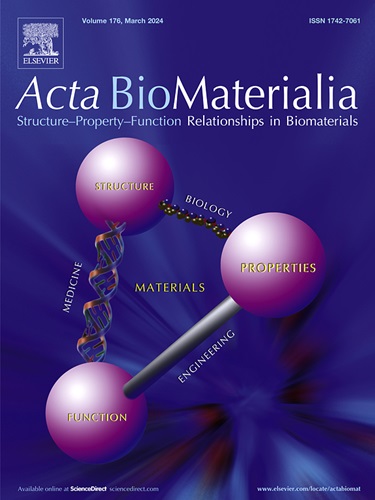Dually functionalized dendrimer for stimuli-responsive release of active ingredients into the skin
IF 9.4
1区 医学
Q1 ENGINEERING, BIOMEDICAL
引用次数: 0
Abstract
The skin, our largest organ, protects against environmental dangers but is vulnerable to various conditions like infections, eczema, dermatitis, psoriasis, skin cancer, and age-related collagen and elastin degradation. Its outer layer, the water-impermeable epidermis, presents challenges for passive drug delivery to the lower living layers of the skin. An ideal dermal delivery system should penetrate the epidermis and release treatments over time. We report a stimuli-activated nanocarrier that slowly releases active ingredients under skin-specific conditions. Using a fourth-generation polyamidoamine (PAMAM), dendrimer functionalized with poly(2-ethyl-2-oxazoline) and palmitoyl pentapeptide-4, we show a controlled release of biologically active therapeutics into the dermis of the skin for 24 h. Ex vivo studies demonstrate that our nanocarrier system delivers cargo to the dermis and is non-toxic to skin fibroblasts. As a proof of principle, we demonstrate a system that effectively enhances collagen production in human dermal fibroblasts by co-delivering all-trans retinol and palmitoyl pentapeptide-4. Our nanosystem surpasses the effects of individual components. This nanocarrier offers a promising approach for targeted dermal delivery, potentially improving treatment efficacy for various skin conditions while minimizing adverse effects associated with traditional formulations.
Statement of Significance
In this manuscript we introduce a stimuli-responsive nanocarrier based on a G4-PAMAM dendrimer functionalized with poly(2-ethyl-2-oxazoline) (POZ) and palmitoyl pentapeptide-4, designed to deliver biomolecules specifically to the skin. The nanocarrier enables controlled, stimuli-triggered release under skin-specific conditions (pH 5, 37 °C), enhancing dermal penetration and minimizing release at neutral pH or lower temperatures. This work improves traditional dendrimer systems by reducing toxicity through POZ, ensuring controlled delivery without invasive techniques like iontophoresis, and co-delivering both a small molecule (all-trans-retinol) and a collagen-stimulating peptide for enhanced therapeutic effects. This system addresses major drug delivery challenges, sets a new precedent for safer, multifunctional nanomaterials, and advances dendrimer chemistry, opening new possibilities in targeted therapies, skin treatments, and materials science.

双功能树突状物刺激反应释放活性成分到皮肤。
皮肤是我们最大的器官,可以保护我们免受环境的危害,但也容易受到各种情况的影响,比如感染、湿疹、皮炎、牛皮癣、皮肤癌,以及与年龄相关的胶原蛋白和弹性蛋白降解。它的外层,即不透水的表皮,对药物被动递送到皮肤下层的活性层提出了挑战。一个理想的真皮输送系统应该穿透表皮,并随着时间的推移释放治疗。我们报告了一种刺激激活的纳米载体,在皮肤特定条件下缓慢释放活性成分。使用第四代聚氨基酰胺(PAMAM),树状大分子功能化聚(2-乙基-2-恶唑啉)和棕榈酰五肽-4,我们展示了生物活性治疗药物在皮肤真皮层的可控释放24小时。体外研究表明,我们的纳米载体系统将货物运送到真皮层,对皮肤成纤维细胞无毒。作为原理证明,我们展示了一个系统,通过共同递送全反式视黄醇和棕榈酰五肽-4,有效地增强了人类真皮成纤维细胞中胶原蛋白的产生。我们的纳米系统超越了单个组件的影响。这种纳米载体为靶向真皮递送提供了一种很有前途的方法,有可能提高各种皮肤状况的治疗效果,同时最大限度地减少与传统配方相关的副作用。意义声明:在这篇论文中,我们介绍了一种基于G4-PAMAM树状大分子的刺激响应纳米载体,该树状大分子被聚(2-乙基-2-恶唑啉)(POZ)和棕榈酰五肽-4功能化,旨在将生物分子特异性地递送到皮肤上。该纳米载体能够在皮肤特定条件下(pH值5,37°C)控制刺激触发释放,增强皮肤渗透,并在中性pH值或较低温度下最大限度地减少释放。这项工作通过减少POZ的毒性来改进传统的树状大分子系统,确保在没有离子导入等侵入性技术的情况下控制递送,并共同递送小分子(全反式视黄醇)和胶原刺激肽以增强治疗效果。该系统解决了主要的药物输送挑战,为更安全、多功能的纳米材料开创了新的先例,并推进了树突化学,为靶向治疗、皮肤治疗和材料科学开辟了新的可能性。
本文章由计算机程序翻译,如有差异,请以英文原文为准。
求助全文
约1分钟内获得全文
求助全文
来源期刊

Acta Biomaterialia
工程技术-材料科学:生物材料
CiteScore
16.80
自引率
3.10%
发文量
776
审稿时长
30 days
期刊介绍:
Acta Biomaterialia is a monthly peer-reviewed scientific journal published by Elsevier. The journal was established in January 2005. The editor-in-chief is W.R. Wagner (University of Pittsburgh). The journal covers research in biomaterials science, including the interrelationship of biomaterial structure and function from macroscale to nanoscale. Topical coverage includes biomedical and biocompatible materials.
 求助内容:
求助内容: 应助结果提醒方式:
应助结果提醒方式:


